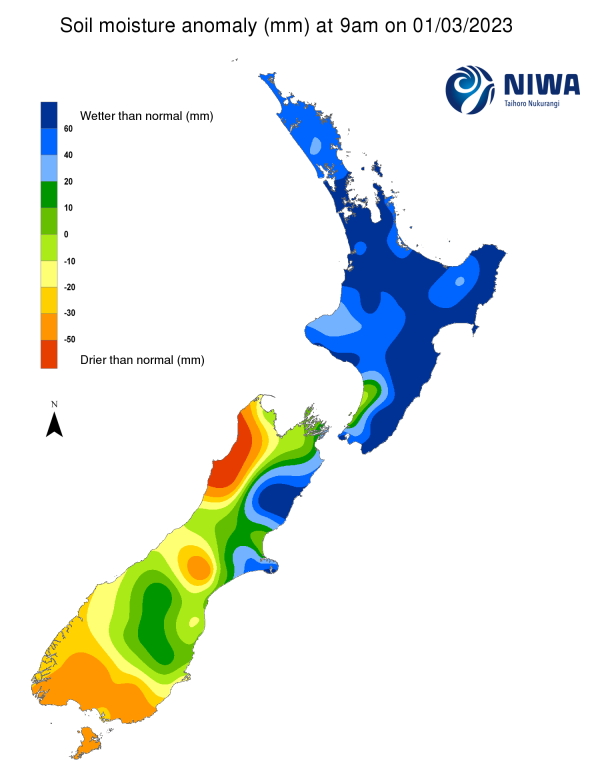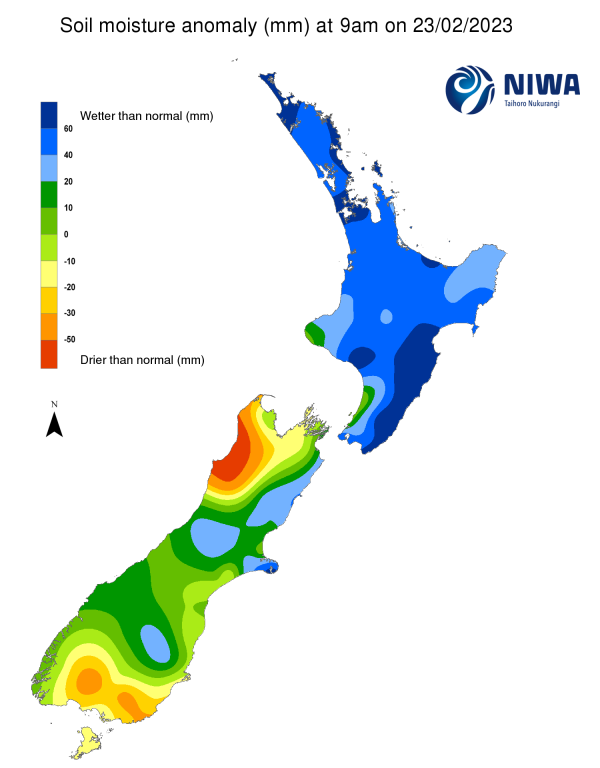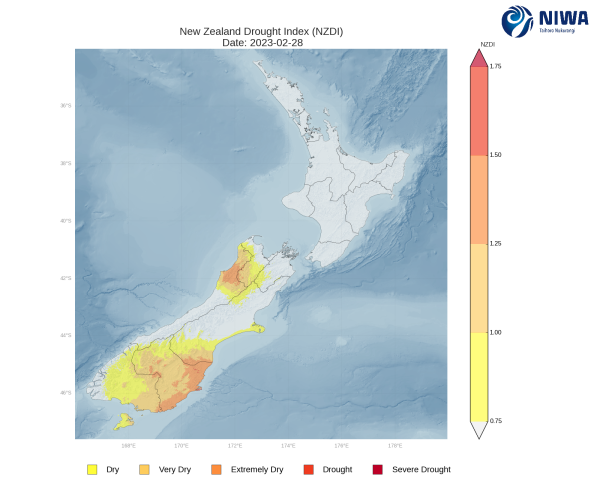A weekly update describing soil moisture patterns across the country to show where dry to extremely dry conditions are occurring or imminent.
Regions experiencing significant soil moisture deficits are deemed “hotspots”. Persistent hotspot regions have the potential to develop into drought.
Facts: soil moisture
In the North Island, the past week once again brought heavy rain to Gisborne and Hawke’s Bay, where amounts of 100-200 mm were widespread. Amounts of 75-100 mm were also observed in parts of the Coromandel Peninsula and Auckland. Lesser amounts of 30-60 mm occurred in much of Bay of Plenty, Waikato, the Central Plateau, Taranaki, and Wairarapa. Conversely, light rainfall amounts of less than 25 mm were observed in much of Northland, Manawatū-Whanganui, and western Wellington. This resulted in much of the North Island seeing moderate soil moisture increases in the past week, with soils generally remaining much wetter than normal for the time of year. However, some soil moisture decreases did occur in Northland and coastal Manawatū-Whanganui. The driest soils across the North Island, when compared to normal for this time of the year, are found along the Kapiti Coast, while the wettest soils for this time of the year are found across large swaths of the island.
No hotspots are currently located in the North Island.
In the South Island, significant rainfall of 50-100 mm fell in eastern Marlborough and northern Canterbury in the past week, along with an area of 30-50 mm in the lower West Coast. Generally light rainfall totals of 15-25 mm occurred in the upper South Island and central Canterbury, with meagre amounts of less than 10 mm in the upper West Coast, southern Canterbury, Otago, and Southland. This resulted in moderate soil moisture decreases for many areas, although some increases occurred in Marlborough and northern Canterbury. The driest soils in the South Island, when compared to normal for this time of the year, are located in Buller District, while the wettest soils for this time of the year are found in northern Canterbury and Banks Peninsula.
A couple of small hotspots are now located in coastal Buller District, with scattered hotspots also observed across Southland. As of 28 February, the New Zealand Drought Index (NZDI) map below shows that dry to extremely dry conditions are currently located in large portions of the northwestern and lower South Island, along with Stewart Island. In addition, small portions of eastern Otago (including the Dunedin area) are experiencing meteorological drought.
Outlook and soil moisture
In the North Island, high pressure will deliver mostly dry weather on Friday (3 March), but scattered showers and isolated thunderstorms will be possible during the weekend. After mostly dry weather on Monday and Tuesday (6-7 March), a cold front may bring light to moderate rainfall to western areas during the middle of next week. Weekly rainfall totals of 15-30 mm are likely in western and central portions of the North Island, while northern and eastern regions are expected to receive 15 mm or less.
Due to the expected rainfall in the next week, soil moisture levels are likely to decrease across a majority of the North Island, most notably in northern and eastern regions, with smaller decreases elsewhere. No hotspots are expected to form in the next week.
In the South Island, periods of light to moderate rain will impact upper and eastern areas from late Friday through early Sunday (3-5 March). After a mostly dry period through Tuesday morning, heavy rain is forecast to develop along the West Coast during the middle of next week. Some light to moderate rain may also affect the eastern South Island during this time. Weekly rainfall totals could reach 100-150 mm along the West Coast, with 30-60 mm possible in northern and central Canterbury. However, lighter amounts of 15-30 mm are expected in Marlborough Sounds, Otago, and Southland.
Due to the expected rainfall in the next week, soil moisture levels will likely increase moderately along the West Coast and in northern and central Canterbury. However, some decreases will be possible in Otago and Southland. The current small hotspots in Buller District will likely dissipate during the next week, although hotspots in Southland may strengthen.
For more information on the potential for dryness in the weeks to come, please check out the drought forecasting tool, a collaboration between NIWA and the Ministry for Primary Industries.
Background
Hotspot Watch: a weekly advisory service for New Zealand media. It provides soil moisture and precipitation measurements around the country to help assess whether extremely dry conditions are imminent.
Soil moisture deficit: the amount of water needed to bring the soil moisture content back to field capacity, which is the maximum amount of water the soil can hold.
Soil moisture anomaly: the difference between the historical normal soil moisture deficit (or surplus) for a given time of year and actual soil moisture deficits.
Definitions: “Extremely” and “severely” dry soils are based on a combination of the current soil moisture status and the difference from normal soil moisture (see soil moisture maps at https://www.niwa.co.nz/climate/nz-drought-monitor/droughtindicatormaps)
Hotspot: A hotspot is declared if soils are "severely drier than normal" which occurs when Soil Moisture Deficit (SMD) is less than -110 mm AND the Soil Moisture Anomaly is less than -20 mm.
Pictured above: Soil Moisture Anomaly Maps, relative to this time of year. The maps show soil moisture anomalies over the past two weeks.
As of 28 February, the New Zealand Drought Index (NZDI) map below shows that dry to extremely dry conditions are currently located in large portions of the northwestern and lower South Island, along with Stewart Island. In addition, small portions of eastern Otago (including the Dunedin area) are experiencing meteorological drought. Please note: some hotspots in the text above may not correspond with the NZDI map. This difference exists because the NZDI uses additional dryness indices, including one which integrates the rainfall deficit over the past 60 days. Changes are therefore slower to appear in the NZDI compared to soil moisture anomaly maps that are instantaneously updated.




